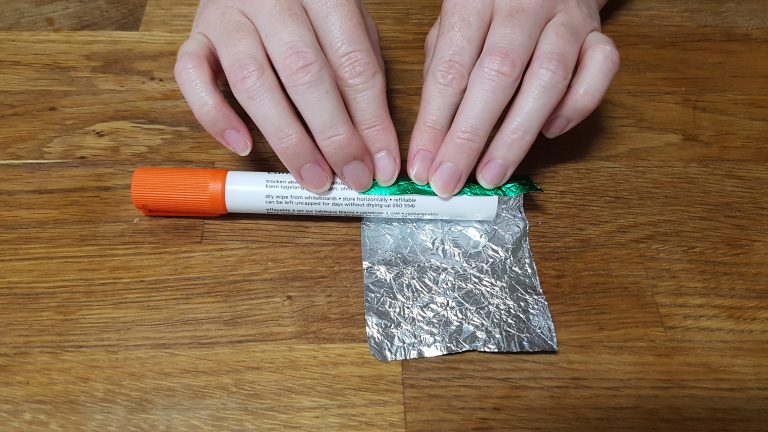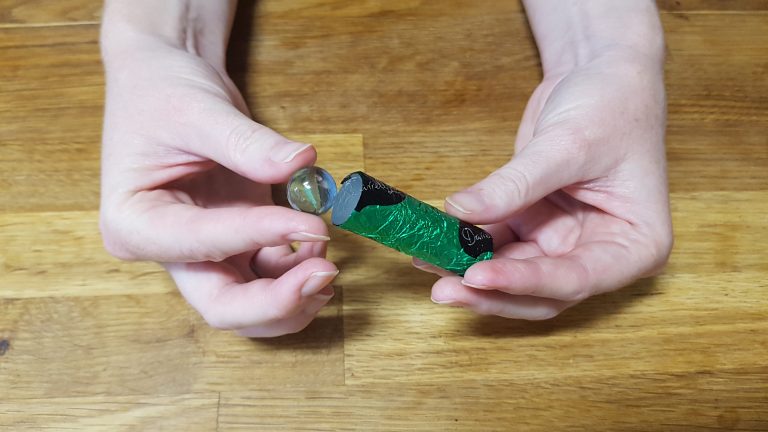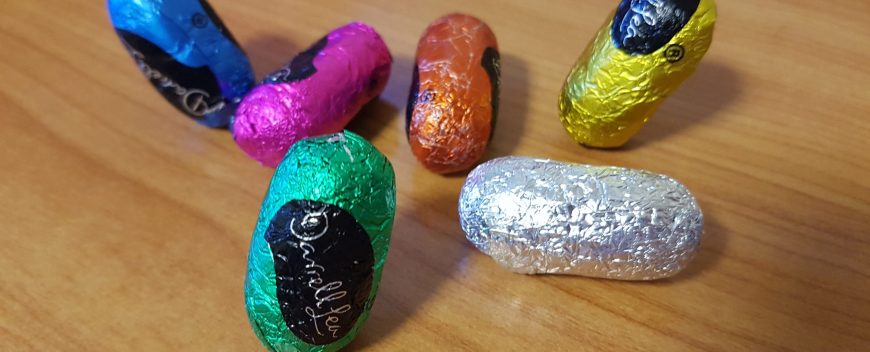Materials
- Easter egg wrappers or aluminium foil
- Marbles
- Plastic container with lid
- Cylindrical object with diameter slightly bigger than the marble’s (e.g. whiteboard marker)

Instructions
- If you’re using foil, cut or tear it into pieces approximately 8cm x 6cm. Use a ruler to help you tear it straight. If you’re using Easter egg wrappers, smooth them out.
- Starting at the short edge, roll the foil around the marker, leaving about 1.5-2cm hanging over the end of the marker.

- Firmly press the overhanging ends of foil around the end of the marker to close one end of the foil tube.

- Slide your foil tube off your marker and drop a marble inside.

- Carefully pinch and fold over the other end of the tube to enclose the marble, taking care not to squash the tube (the marble should have space to move around inside). Don’t worry if it’s not very neat – we’ll fix that in the next step.

- Place the foil package inside the container, put the lid on, and shake it until the ends are rounded and smooth.
- Roll your completed jumping bean around to see how it moves!

Further Investigation
- Try different sizes of foil and marbles to make more beans, and observe how they move differently.
- How does the bean’s movement change if you use several smaller balls in place of the marble?
- Try rolling the bean down a sloping surface, such as a piece of heavy cardboard. The foil is smooth and a bit slippery – how could you make it grip the surface better?
- Can you design a similar rolling toy made from paper or cardboard?
What's happening?
When you shake the jumping bean around in the container, the foil gets squashed between the marble and the sides of the container. This creates the bean’s smooth, rounded ends.
As the bean rolls along, the marble and the foil move separately from each other. Although it may look like it’s not moving, the marble is secretly rolling along inside the foil. The marble keeps rolling until it hits the end of the foil tube. The foil tube flips over, and the marble continues rolling until it hits the other end.
This fun experiment gets its name from an actual Mexican plant (Sebastiana pavoniana) which has a very special relationship with a species of moth (Cydia deshaisiana). The moth lays its eggs inside the seed pod of the plant, and when the larvae hatch, each one burrows inside its own seed, eats out the middle, and lives in there for several months. When the seed gets warm (e.g. by someone holding it in their hand), the larva moves around, making the seed jump in a very similar way to these foil ones!
Check your understanding
- Describe the push and pull forces that make the jumping bean move.
- On what type of surface did the jumping bean move best?
- How did the Mexican Jumping Bean get its name?
Curriculum Links
- Prep Physical Sciences: The way objects move depends on a variety of factors, including their size and shape (ACSSU005)
- Year 2 Physical Sciences: A push or a pull affects how an object moves or changes shape (ACSSU033)
- Year 4 Physical Sciences: Forces can be exerted by one object on another through direct contact or from a distance (ACSSU076)



